Dr. Gopal Midha and Dr. Tanushree Rawat
Assessment and evaluation is an integral part of a teacher’s job; she spends her days looking at student work, trying to ascertain how much and how well her wards have absorbed the lessons she has delivered, and thinking about what more they need to do to prepare for the next round of tests. For teachers dealing with board-facing classes, this becomes an even more fraught and urgent exercise. But what about her performance? Generally, teacher performance is gauged based on student performance, but that’s only half (or less than) of the story. Over time, more nuanced and context-sensitive approaches have been developed to understand how (and how well) a teacher is handling the classroom. Subject or domain knowledge and its transfer are one aspect, but there are many others that contribute to how effectively a teacher engages with a class. The three pieces that make up our cover package for this issue address the thorny and very sensitive issue of assessing a teacher, using observation, dialogue, and reflection as tools. In one article, the authors develop a case that illustrates how we might navigate the complex conversations around performance. In another, the author offers an argument and approaches to a systemic overhaul of teacher assessment. And a third shorter piece offers some pointers for conducting classroom observations. Together, they allow us to think not only more systematically but also contextually about working with teachers and recognizing their individual and other challenges and strengths and using these as the starting point for fairer, more empathetic assessments.
Vimal, Sneha, and Ashraf stepped out of the math session they had just observed and walked into the staff room to discuss how effective Tejinder, the new grade 6 math teacher, had been. As soon as they had filled their cups with chai, Sneha, the primary school math teacher, glanced at her notes and began:
“I think Tejinder did a fantastic job with teaching ratios. I loved how he began by asking students to compare how long each student took to reach the school. It was a great experience-based intro into the topic, just like Pamela Liebeck explains in the ELPS (Experience – Language – Picture – Symbol) model on how to teach math.”
Vimal, the high school math teacher, interjected, “And how easily he maintained discipline with the 40 children. No easy task. Smooth transitions from questions to answers, lots of pauses for reflection and the revisions at the end of the session. Great classroom management – simply marvellous!”
They both looked at Ashraf, the middle school math teacher from the neighbouring school. Ashraf looked around the empty staff room and said, “I think he made a few mistakes in the class – he added two ratios wrongly and then his example of comparing ratio of travel time with distance was mathematically flawed. What is the point of teaching math if your domain knowledge is incorrect?”
Vimal and Sneha looked at Ashraf and then they all looked outside the window at the tree swaying in the breeze.
“Teacher evaluation is tricky,” sighed Sneha. “Just 40 minutes of observing the same class shows how differently we observe and evaluate.”
Sneha’s long sigh was broken by the sight of Tejinder who entered the staff room with principal Afreen.
“So, how well did I teach?” Tejinder asked.
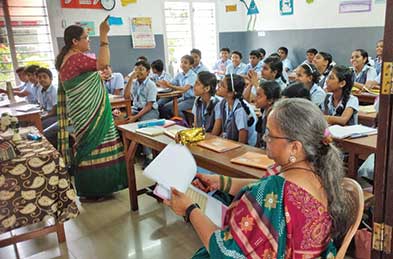
Whether you identify yourself with the observer, the teacher, or the principal in the case above, you will probably agree with Sneha that evaluating teachers and their teaching is difficult. Most educators we know call it a wicked problem – a problem that is difficult to define, a problem without an inherent logic that signals when it is solved and a problem whose solutions aren’t true or false but only good or bad.
But merely because a problem is wicked, does not mean we throw our hands up in despair. In this article, we ask a few questions and share a few suggestions on the what, how, and why of teacher evaluation. We have arrived at our suggestions after talking with teachers, teacher educators, school headmasters, college principals, policy specialists and researchers, and by reflecting upon our own teaching experiences. Though most research we found does not relate to Indian classrooms, we would like to nudge you towards ‘good’ teacher evaluation – drawing on the wisdom and practices that have worked in uniquely Indian scenarios.
We have created a case, comprising everyday talk that you might hear in a school staff room, to penetrate, unpack, and illuminate the thinking and practices we found helpful. We also realized that although there is a wealth of scholarly material available on teacher evaluation, the ideas are often wrapped in complex words (holistic evaluation, essential tension) and theoretical terms (sense-making, collective efficacy) that are more familiar to those in academia. To build familiarity, we have tried to present this simply, but we haven’t shied away from theoretical terms either – instead we define the terms with examples and urge teachers and principals to use them so that they can participate in the research dialogue.
To structure this article, we present snippets of conversations from the case and then provide a brief commentary to pinpoint and clarify teacher evaluation. So let us continue the case from where the principal, Afreen, and the teacher, Tejinder, have entered the staffroom.
Ashraf smiles at Tejinder and says, “Thank you for letting us observe your session. Tell us a bit more about how you feel the class went, what worked well and what perhaps could have been done differently?”
Ashraf’s first comment serves to begin our inquiry into the ‘how’ and the ‘who’ of evaluation. Ashraf’s move to ask the teacher for his own assessment (self-review) is essential to any teacher evaluation because it encourages the teacher to reflect upon and anchor the conversation with what he discovered. Shala Siddhi, a Government of India framework for school improvement, emphasizes self-reflection as a core standard, as do the guidelines under another helpful and freely available resource, the Advancement of Educational Performance through Teacher Support (ADEPTS).
One way we like to organize self-reflection is how Argyris and Schön delineate them into reflections that happen during teaching such as a question from a student that surprises the teacher when she is teaching (reflection in action) and those that occur after the session, such as when a teacher wonders later about why students were behaving in a particular way (reflection on action).
The presence of Vimal, Sneha, and Ashraf is effective because they are all math teachers who either teach different grades or teach in a different school. Tejinder’s experience of teaching middle school helps both Vimal and Sneha to potentially chart the math teaching-learning trajectory of students and reflect on their own teaching actions. Ashraf brings in an outsider’s eye to illuminate the water (school culture) that might be invisible to the fish (Vimal, Sneha, Tejinder, and Afreen). Finally, Afreen’s presence helps the school become a learning organization. Since Afreen participates in several teacher evaluation meetings, she can easily disseminate good teaching practices, wise evaluation questions, and even connect two teachers who she feels can learn from each other.
We return to the case as Tejinder takes a deep breath, furrows his brow and replies: “Hmmm…I feel that my design of starting from students’ experience before showing the formulae paid off. But when I was comparing the travel time with distance, I got confused. Other than that, the activities ensured that students were well behaved, they were listening well and we had good class discipline. I think they liked discussing with each other how long it took them to come to school.”
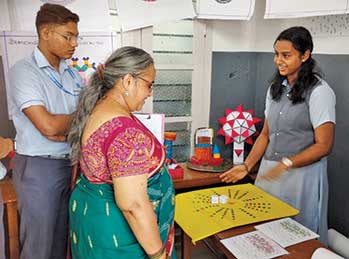
Using the excerpt above, let us consider ‘what’ teacher evaluation may comprise. Tejinder’s self-reflection illuminates three different kinds of knowledge as described below:
• Organizing the classroom and managing students or general pedagogical knowledge (GPK) seen in how Tejinder managed the students (listening well, discipline, group work). Vimal’s comment at the beginning of this article also captures GPK.
• Knowing the topic being taught or content knowledge (CK) – seen in Tejinder’s knowledge of mathematical topics of time, distance, ratios. Asraf’s comments in the first few lines of the case capture gaps in Tejinder’s CK.
• (Re)structuring the content and presenting it in a way that takes advantage of the students’ unique abilities, interests, preconceptions, and difficulties or pedagogical content knowledge (PCK) – seen in how Tejinder draws upon students’ experience of travel time because he knows that introducing a concept like ratios must begin with something that his students experience every day. Sneha’s comment in the initial lines from the case describe PCK. The concept of PCK is helpful because it makes us think about how content is inseparable from its teaching. Content is rarely like a readymade pizza which can simply be delivered. Teachers must constantly adapt their teaching to what they are trying to educe.
The three knowledge bases (GPK, CK, PCK) are often credited to Lee Shulman who also identified four other types of knowledge. Yet, for us, these three bases are the core. More importantly, considering CK, GPK, and PCK means that when we discuss evaluation for a middle-school math teacher versus a middle-school English teacher, the talk points must go beyond classroom discipline to how ratios are taught differently as compared to essay writing.
Let us return now to how the others respond to Tejinder’s self-review: Ashraf continues, “I think you are spot on Tejinder. I also feel that since these are your initial years as a teacher, it might be wise to have a mentor or maybe even join an association (he looks at Afreen to see if she agrees). I usually ask my colleagues at the math association for strategies that they use to teach concepts and what is new in the math world. We even have a WhatsApp group. Would you want me to add you there or come to our monthly meetings?
Afreen nods her head, “Sounds great since our school vision is that all our students must be college or job ready. I think good math ability will help crack all the entrance exams and open more job doors, so it would be a good check to learn from more experienced teachers on how they do this. Ashraf’s math association monthly meetings look like a good idea.”
This excerpt touches upon the ‘why’ of teacher evaluation from a philosophical angle-capturing how everyone ‘sees’ the teacher, what is the purpose of evaluation, what is effective teaching and how it differs from ‘good’ teaching.
Ashraf’s mention of a community of math teachers who gather to discuss teaching strategies touches upon how we see teachers differently – as professionals, artists, or delivery agents? It was in 1975 that Lortie compared classrooms to eggs in a crate – physical spaces that teachers enter and then shut the door – and our conversations reflect that most teachers continue to largely operate in isolation even in 2024. Combine this egg-in-a-crate analogy with where we place the teacher on a continuum ranging from professionals with their own voice and artistry to delivery agents of a teacher-proof curriculum.
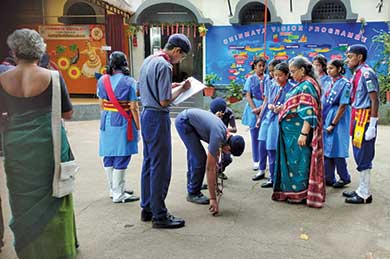
As evaluators, we must ask ourselves whether we are considering the teacher as a delivery agent who must strictly follow rules to ‘cover’ the portion and who is evaluated based on a number-driven outcome (example: what percentage of students scored above 90%). In contrast, as shown in the case above, even novice teachers such as Tejinder can be treated as professionals to include their voice and interpretations of teaching. For instance, in the philosophical view underpinning the case, the evaluation leans towards a professional learning experience rather than a judgment of teachers/teaching.
Afreen’s comment about the vision manifests her philosophy of assessing effectiveness of teaching as preparing students to be market-ready. We differentiate effective teaching from good teaching. Effectiveness focuses on performance or getting things done to reach a goal (e.g., higher marks in a subject) while good teaching focuses on values or doing what is ethically right for the students. Good teaching might focus on supporting students to become better human beings. If a history teacher encourages her students only to memorize dates and facts, her students may score well but she has probably closed the doors for generating a love for historical thinking and learning from the past. Evaluation, we believe, must consider both effectiveness and goodness.
“Sure, I would like to be part of the math association,” says Tejinder excitedly.
To him, this sounded smarter than searching online for teaching strategies because he could talk to colleagues who probably taught similar size classes and similar student profile classrooms. He could not do that in a WhatsApp group. He might even nudge Ashraf to be a mentor!
Vimal highlighted a point that just occurred to him, “I noticed that students really like you, I could see that in their eyes and their excited voices. I have heard that they have even sent you friend requests! You sure are popular.”
“Yes, and Tejinder seems to be doing well – after all his students scored high on the multiple choice question (MCQ) math paper we received from the education department!,” Afreen added.
Finally, we probe into the ‘who’ of evaluation to examine two popular practices of teacher evaluation.
Sneha and Afreen highlight another dimension of assessing teachers – student evaluation of teaching and student scores/performance. In our research we found that both student evaluation and student scores are imperfect indicators of teaching-learning and might be harmful if they are the sole indicators of assessing teaching.
Let us consider student evaluation either through surveys or noticing how students behave with a teacher. Studies show that surveys are problematic as those who design the survey usually have different ideas regarding what good teaching looks like compared to those who answer the survey. Students respond to surveys based on their own criteria for good teaching such as likability of a teacher and the expectation for a higher score. A teacher who asks difficult questions, pokes at misconceptions or re-examines students deepens learning, but often is the target of students’ ire. A teacher who provides a question bank and then tests students on the same questions may be very popular and highly rated by both parents and students, and yet might leave students with little knowledge and conceptual understanding of the subject.
Student scores on an exam (especially MCQ papers) must be used with caution to evaluate teachers. First, scores do not offer insights into what students think or how knowledgeably they act outside the classroom. Scoring well in an exam is also about how well students can ‘play’ the test. Second, student scores are biased. Even in math, a subject where there are clear right and wrong answers, two teachers will score the same math paper differently (Romagnano). Finally, in our experience, marks that students earn also depend on a number of school variables which are outside the control of teachers – from the availability of materials in the chemistry laboratory to the quality of books in the library.
Thankfully, Sneha agrees with our reading of research as seen below.
Sneha: “Hmm…I would hesitate to use popularity to measure teacher effectiveness. I am coming around to the view articulated in ADEPTS:
Teacher Performance + Supporting factors (professional development, institutional backing, sufficient time for peer-learning) -> Teacher effectiveness.”
Vimal added, “Yes, and we know that performance, in turn, needs more than a competent teacher. If Tejinder was teaching in a class of 50 students, our conversation today would have been very different, right?”
Afreen’s phone rang and she listened intently for a minute before hanging up, “Crisis time, have to rush for a school board meeting. Why don’t we meet again this Saturday in my office? Sneha, would you please propose a sample evaluation form based on our chat today and performance standards from ADEPTS? We will treat it as a starting point – incomplete and incomprehensive – but a much needed starting point. Later we will add the topic related dimensions.”
As soon as Afreen left, Sneha put on a face and said, “Why is it always me who gets to do the first draft?”
“Because you are going to be the next principal,” quipped Ashraf as they all burst into laughter.
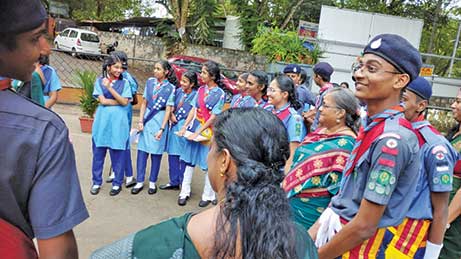
Finally, a key value of teacher evaluation is to think of it sincerely and playfully – with a healthy dose of laughter and banter. A wicked problem such as teacher evaluation and the pressure of it being used to rate teachers on promotions can get serious. That is why treating it as a learning experience works better for motivation than a one-shot judgement.
We conclude the article with a summary of suggestions for teacher evaluation and also offer you the work-in-progress evaluation template that Sneha brought to the next meeting. We urge you to adapt, tweak, or modify the template. If you haven’t as yet, do begin on this collaborative, messy, iterative, and playful journey of teacher evaluation. If you already have a system in place, it might be time to explore its philosophical underpinnings and talk more about ‘good’ teaching. Our students deserve it.
Suggestions for teacher evaluation
• What – Demarcate based on CK, PCK, and GPK.
• Who – Involve peer teachers for in-class observations, use student evaluation with caution, student scores, in isolation, are a poor measure. Engage the principal to disseminate learning.
• Why – Inquire how you see the teacher and the role of teaching? Align everyone’s thinking before evaluation. Discuss effectiveness and goodness.
• How – Begin with self-review. Use tools for self-reflection, Use a mix of observation, interview, and documents, Remember that standards and tools are always interpreted.
Teaching Evaluation Template (work in progress)
Participants: Teacher being evaluated + evaluators: Peers from the same field + school principal
- It is essential that the evaluators are people who have expertise in the field and themselves have knowledge of CK, GPK, and PCK – peer teachers are a great resource for this.
- School principals are an essential part of evaluation reflection meetings. They can disseminate the learning that emerges in these conversations. They can also relate the effects of a teacher’s work in the classroom to the big picture, such as how it leads to actualization of the school vision.
- Besides observations, look at documents (student notebooks, lesson plan, images of the blackboard and groupwork) for each point below.
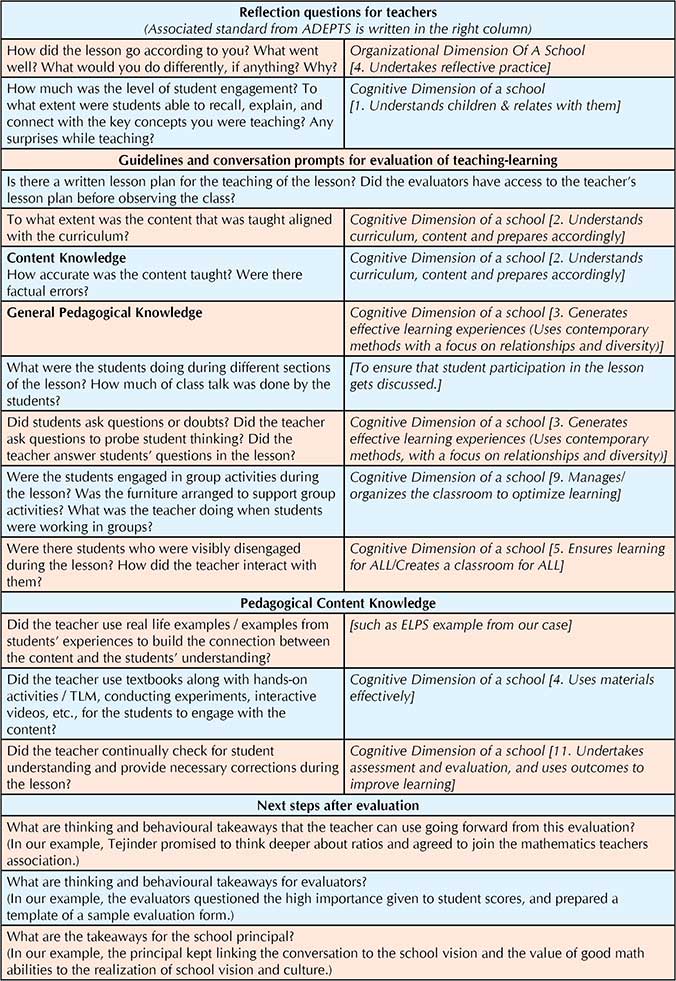
Resources
• Shala Siddhi: https://shaalasiddhi.niepa.ac.in/presentations.html#loaded
• Argyris and Schon’s theory of learning: https://infed.org/mobi/chris-argyris-theories-of-action-double-loop-learning-and-organizational-learning/
• ADEPTS: https://prayatna.typepad.com/files/adepts.pdf
• CETE (2022) Higher Order Teaching with Inclusion & Equity (HOTIE)
• Shulman’s knowledge types: https://www.wcu.edu/webfiles/pdfs/shulman.pdf
Dr. Gopal Midha holds a PhD in Education from the University of Virginia and is the founder, shiksha ek khoj. He has taught math and English to grade 5 and 6 and Education Leadership to MA students at Tata Institute of Social Sciences (TISS), Mumbai. Besides teaching, he loves theatre, film-making and storytelling which he uses in professional development workshops. He can be reached at gopalmidha@gmail.com.
Dr. Tanushree Rawat works at the Center of Excellence in Teacher Education, TISS, Mumbai as Research Coordinator for CL4STEM (an international project aimed at developing the capacities of teachers in Nigeria, Bhutan and Tanzania), and is also the instructor for the Education Leadership and Management course. She received her PhD in Educational Leadership and Policy Analysis from the University of Wisconsin-Madison, USA. She can be reached at Tanushree.rawat@tiss.edu.
Related Articles
